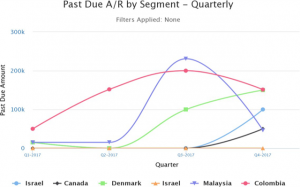Benefits of Customer Segmentation in Collections
Segmenting customers for Collections into buckets of strategic accounts and providing an insight into Collections process for faster operations
Benefits of Customer Segmentation in Collections
As discussed in the previous chapter customer segmentation significantly boosts collections output. The following explores the key benefits of customer segmentation.
Improve Customer Experience
In the current world with cut-throat competition, customer experience is the only differentiator and providing a world-class experience with invoicing and collections will go a long way in sustaining competitive advantage. The collections process encompasses a multitude of touch-points with the customers in day-to-day operations. However, traditionally collections process has been solely about money with little or no focus on individual financial conditions or limitations of a customer. Customer segmentation ensures a holistic approach towards this outdated motto and helps the collections team to correspond with the customers using targeted and tailored collections strategies to address their multi-faceted needs. For example, customers who need paper invoicing may require invoice delivery 15 days prior as compared to customers who opt for e-invoicing. Customer satisfaction is often the number one driver for competitive advantage and profitability, and post-sales customer experiences in A/R processes go a long way in providing a strategic lift to businesses.
De-clutter the Collections Worklist
As stated in the previous chapter, McKinsey?s report states that more than 70% of collection calls made by collectors are wasted as these are made to the customers would have paid even in the absence of these calls. An easy way to deal with these wasted efforts could be to create a customer segment- ?fast paying customers? that would refocus the collections activity on high-risk accounts. These focused strategies for individual buckets include proactive invoicing, zero-touch automation and escalated correspondence measures. This, in turn, helps in refining account prioritization and collections worklist. Customer segmentation, therefore, is imperative for generating prioritized worklists and removing redundant items in the worklist to improve collector productivity. For instance, a customer with a history of multiple disputed invoices would ideally need a collections strategy which helps in identifying potential disputes as soon as possible. This strategy would contribute towards re-prioritization of worklist eliminating (or reducing the priority of) disputed invoices.  This would not only enable collectors to focus on more strategic, ?at-risk? accounts but also help calibrate collections effort to tap the low hanging fruits with more clarity in the worklist.
This would not only enable collectors to focus on more strategic, ?at-risk? accounts but also help calibrate collections effort to tap the low hanging fruits with more clarity in the worklist.
Adopt to Dynamic Changes in Customer Behavior
With the evolving economy, it is imperative for collections strategies to be elastic and adaptable to the changes in customer behavior and market trends. To give a small example, in 2009, Nokia was the #1 mobile handset manufacturer in the world. A company that supplied display panels to Nokia would have treated it as a strategic account at that time. However, within 5 years Nokia was nowhere to be seen in the top mobile handset manufacturers. This example shows the importance of being nimble with the credit and collections process and keeps tabs on the changes in the market and the industry. Customer Segmentation helps collections teams take dynamic factors into account while segregating customers and formulating strategies for different combinations of these factors. Another example could be, a mid-market customer with a double-digit growth rate has evolved from a low risk, non-strategic account to a low (or medium) risk, strategic customer, the collections strategy for this customer should reflect the leniency in prompt follow-ups and less frequent reminders. Segmentation ensures that the dynamic changes in customer behavior are well-incorporated and addressed in the collections strategies.
Improve Productivity and KPIs
With a de-cluttered worklist, the analysts have a smooth process and workload of focusing only on the critical accounts while sending mass correspondence and emails to less critical accounts. This approach not only improves account coverage significantly but also enables analysts to focus on the ?at-risk? accounts in a timely fashion. Customer segmentation has a two-fold role in easing the pre-correspondence workload of collectors:
- It helps collectors deal with the idiosyncrasies associated with each customer segment
- It prevents the need to formulate a communication strategy for each INDIVIDUAL customer
It also helps improve the Collector Efficiency Index that measures the amount collected during a specific period of time against the amount of the total receivable during that same period, and Profit Per Account (PPA) which measures how much profit is generated on average by each account in collections. 
